
Urdu is an Indo-Aryan language spoken chiefly in South Asia. It is the national language and lingua franca of Pakistan. In India, where Urdu arose, it is an Eighth Schedule language, the status and cultural heritage of which are recognised by the Constitution of India. It also has an official status in several Indian states.

Hindustani is an Indo-Aryan language spoken in North India and Pakistan, and functioning as the lingua franca of the region. It is also spoken by the Deccani people. Hindustani is a pluricentric language with two standard registers, known as Hindi and Urdu which serve as official languages of India and Pakistan, respectively. Thus, it is also called Hindi–Urdu. Colloquial registers of the language fall on a spectrum between these standards. In modern times, a third variety of Hindustani with significant English influences has also appeared, which is sometimes called Hinglish or Urdish.

Svaha, also referred to as Manyanti, is the Hindu goddess of sacrifices featured in the Vedas. She is the consort of Agni, and the daughter of either Daksha or Brihaspati, depending on the literary tradition. According to the Brahmavaivarta Purana, she is an aspect of Prakriti (nature), an element without which Agni cannot sustain.

Vayu, also known as Vāta and Pavana, is the Hindu god of the winds as well as the divine messenger of the gods. In the Vedic scriptures, Vayu is an important deity and is closely associated with Indra, the king of gods. He is mentioned to be born from the breath of Supreme Being Vishvapurusha and also the first one to drink Soma. The Upanishads praise him as Prana or 'life breath of the world'. In the later Hindu scriptures, he is described as a dikpala, who looks over the north-west direction. The Hindu epics describe him as the father of the god Hanuman and Bhima.
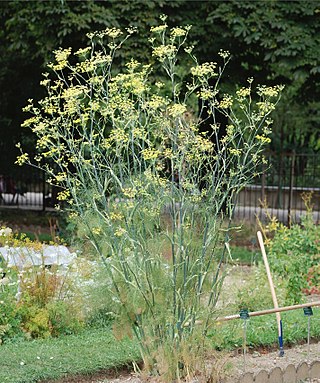
Fennel is a flowering plant species in the carrot family. It is a hardy, perennial herb with yellow flowers and feathery leaves. It is indigenous to the shores of the Mediterranean but has become widely naturalized in many parts of the world, especially on dry soils near the sea coast and on riverbanks.
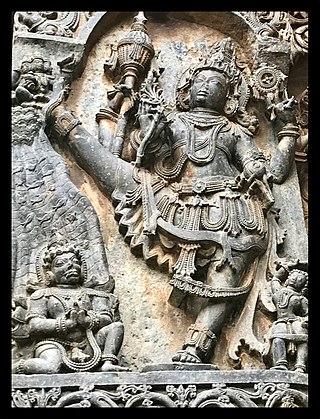
Trailokya literally means "three worlds". It can also refer to "three spheres," "three planes of existence," and "three realms".

Janaka is the King of Videha who ruled from Mithila, in the Hindu epic Ramayana. Janaka was married to Sunayana. He is the father of Sita and Urmila in the epic. The term Janaka was also the title adopted by all the kings of Videha, who were the descendants of the King Nimi and his son King Mithi. The King Mithi is considered as the first King of Videha who was titled with the term Janaka.

Panchamukha, also rendered Panchamukhi, is a concept in Hindu iconography, in which a deity is represented with five heads. Several Hindu deities are depicted with five faces in their iconography, such as Hanuman, Shiva, Brahma, Ganesha, and Gayatri.

The Shiva Tandava Stotra(m) (Sanskrit: शिवताण्डवस्तोत्र, romanized: śiva-tāṇḍava-stotra) is a Sanskrit religious hymn (stotra) dedicated to the Hindu deity Shiva, one of the principal gods in Hinduism and the supreme god in Shaivism. Its authorship is traditionally attributed to Ravana, the ruler of Lanka, considered a devotee of Shiva.

Yali, also called Vyāla, is a Hindu mythological creature, portrayed with the head and the body of a lion, the trunk and the tusks of an elephant, and sometimes bearing equine features.

In Hindu mythology, the Narayanastra is an astra, a celestial missile, affiliated to the Hindu deity, Vishnu, in his form of Narayana.
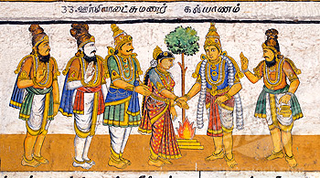
Urmila, is a Hindu goddess and the princess of Videha in the Hindu epic Ramayana. She is considered to be an avatāra of Nagalakshmi, the serpent goddess. Urmila was married to Lakshmana and is known for her dedication towards her husband, for her sacrifice.

Arundhati is the wife of the sage Vasishtha, one of the seven sages (Saptarshi) of Hinduism.

The Hindi–Urdu controversy arose in 19th-century colonial India out of the debate over whether Modern Standard Hindi or Standard Urdu should be chosen as a national language.
A sattvic diet is a type of plant-based diet within Ayurveda where food is divided into what is defined as three yogic qualities (guna) known as sattva. In this system of dietary classification, foods that decrease the energy of the body are considered tamasic, while those that increase the energy of the body are considered rajasic. A sattvic diet is sometimes referred to as a yogic diet in modern literature.
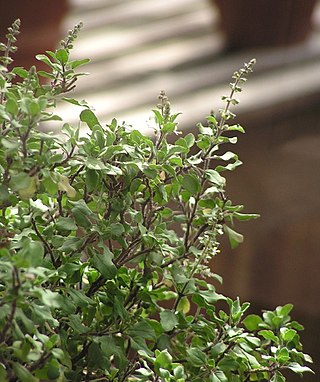
Tulasi, Tulsi or Vrinda is a sacred plant in Hindu tradition. Hindus regard it as an earthly manifestation of the goddess Tulasi; she is regarded as the avatar of Lakshmi, and thus the consort of the god Vishnu. In another iteration, as Vrinda, she is married to Jalandhara. The offering of its leaves is recommended in ritualistic worship of Vishnu and his avatars, like Krishna and Vithoba.
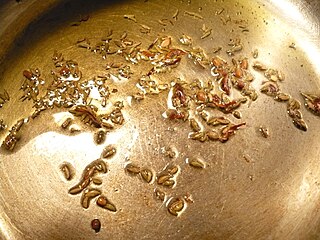
Tempering is a cooking technique used in India, Bangladesh, Nepal, Pakistan, and Sri Lanka in which whole spices are cooked briefly in oil or ghee to liberate essential oils from cells and thus enhance their flavours, before being poured, together with the oil, into a dish. Tempering is also practiced by dry-roasting whole spices in a pan before grinding the spices. Tempering is typically done at the beginning of cooking, before adding the other ingredients for a curry or similar dish, or it may be added to a dish at the end of cooking, just before serving.
Ghritachi is a prominent apsara in Hindu mythology. She is known for her beauty and seduction of many men, both divine and human, and for becoming the mother of their children.

The Bhagavadajjukam is a Sanskrit farce composed in the 7th century CE, usually attributed to Bodhayana. However, inscriptional and scholarly evidence indicate that the play was written by the Pallava king Mahendravarman I, who also wrote a prominent farce known as the Mattavilasa Prahasana. It is one of the two earliest surviving examples of a satirical play in Sanskrit literature. Featuring witty exchanges, an episode about the transmigration of souls and a discussion on Hindu dharma, the comical play was intended to mock the doctrines of Buddhism, whose rise at the time presented a challenge to the dominance of Hinduism in India.

















